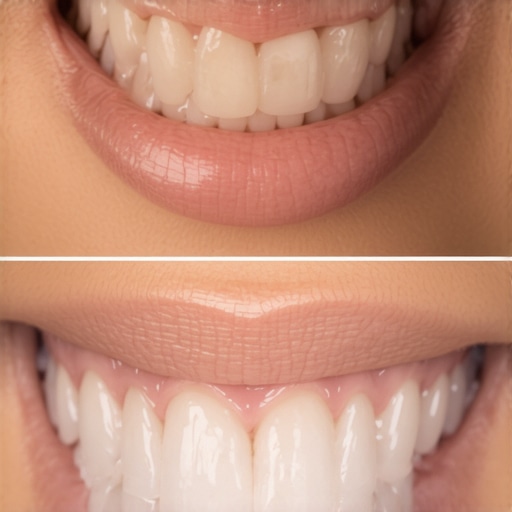Harnessing Advanced Techniques for Comprehensive Family Dental Aesthetics
In the evolving landscape of family dentistry, integrating sophisticated strategies for teeth whitening and Invisalign treatments has become paramount for delivering holistic oral health solutions. As an authority in dental aesthetics, understanding the nuanced interplay between these modalities can significantly enhance patient outcomes and satisfaction.
Synergizing Teeth Whitening and Invisalign: A Paradigm Shift in Cosmetic Dentistry
Historically perceived as separate entities, teeth whitening and Invisalign now synergize within a comprehensive approach to smile enhancement. Modern techniques leverage the timing of orthodontic realignment with bleaching procedures, maximizing aesthetic results while minimizing treatment duration. For instance, aligning teeth before whitening ensures uniform color application, avoiding uneven shades that can compromise aesthetic integrity.
What Are the Intricate Considerations in Coordinating Orthodontic and Whitening Protocols?
Expert practitioners must meticulously plan the sequence of treatments, considering factors such as enamel integrity, the potential for sensitivity, and the longevity of whitening effects post-orthodontics. Recent advances suggest pre-orthodontic whitening may sometimes be preferable, as moving teeth can affect enamel surface and stain resistance. Referencing authoritative sources like the American Academy of Cosmetic Dentistry, clinicians can tailor protocols that optimize both structural and cosmetic outcomes.
Emerging Technologies and Materials in Family Dental Aesthetic Optimization
Innovations such as minimally invasive bleaching agents and clear aligners with integrated whitening capabilities are redefining standards. The adoption of digital smile design further enhances precision, allowing for predictive modeling of combined treatments. For example, Invisalign innovations exemplify how invisible orthodontics can be seamlessly integrated with aesthetic enhancements, delivering comprehensive family smile solutions.
How Can Dental Professionals Address Complexities in Multi-Modal Smile Enhancement?
Managing patient expectations and treatment complexities requires a nuanced understanding of both procedural intricacies and psychological factors. Techniques such as staged treatments, patient education, and ongoing assessment are vital. Engaging with peer-reviewed research and attending specialized workshops ensures clinicians remain at the forefront of this evolving field.
For those seeking in-depth insights into aesthetic dentistry, exploring professional teeth whitening tips can provide valuable guidance. Additionally, contributing your clinical experiences to professional forums can foster a collaborative advancement in family dental aesthetics.
In conclusion, integrating advanced teeth whitening and Invisalign techniques within family dentistry exemplifies the future of comprehensive oral health management, emphasizing both functionality and aesthetic excellence.
Integrating Digital Smile Design for Precision Aesthetic Outcomes
One of the most revolutionary advancements in family dental aesthetics is the adoption of digital smile design. This technology allows clinicians to simulate potential results before commencing treatment, offering patients a visual roadmap of their transformation. By combining digital modeling with traditional treatments such as whitening and Invisalign, practitioners can craft highly personalized plans that address both functional correction and aesthetic desires with unparalleled accuracy.
What Are the Ethical Implications of Combining Multiple Aesthetic Procedures?
As dental professionals increasingly blend various cosmetic techniques, ethical considerations become paramount. Ensuring patients have realistic expectations, informed consent, and understanding of potential risks is essential. Furthermore, prioritizing oral health over purely aesthetic goals safeguards the integrity of family dentistry. For instance, a comprehensive approach considers the long-term impacts of whitening agents on enamel health, especially when combined with orthodontic appliances that may affect oral hygiene. Consulting authoritative sources such as the American Academy of Esthetic Dentistry helps maintain ethical standards while embracing technological innovations.
How Can Practitioners Balance Aesthetic Aspirations with Structural Dental Health?
Achieving this balance requires a nuanced understanding of individual patient anatomy, habits, and overall health. For example, aggressive whitening can sometimes compromise enamel integrity, especially in patients with pre-existing sensitivity or decay. Therefore, a tailored protocol that includes comprehensive examinations, preventive measures, and conservative treatments is vital. Educational resources like teeth whitening secrets can inform both clinicians and patients about safe practices. Additionally, ongoing research into bioactive materials and minimally invasive techniques continues to expand the possibilities for safe, effective aesthetic improvements.

Imagine a detailed digital rendering of a smile transformation, showcasing before-and-after scenarios achieved through combined orthodontic and whitening procedures.
Future Trends: Combining AI and Machine Learning for Personalized Smile Makeovers
Artificial intelligence (AI) and machine learning are poised to revolutionize how family dentists approach aesthetic treatments. By analyzing vast datasets of patient outcomes, AI can predict the most effective treatment combinations tailored to individual needs. This technology enables proactive adjustments, minimizes risks, and enhances patient satisfaction. For example, AI-driven software can recommend optimal timing for whitening post-invisalign or suggest alternative materials for veneers that better match the patient’s unique dental profile. As this field evolves, staying informed through reputable sources like PubMed helps clinicians incorporate evidence-based innovations into their practice.
Are you interested in exploring how AI can personalize your smile makeover plans? Share your thoughts or experiences in the comments below, and discover more about integrating cutting-edge technology in family dentistry.
Innovating with Customized Digital Smile Design: The Next Frontier in Personalized Aesthetic Dentistry
Digital smile design (DSD) transcends traditional planning, offering an unparalleled level of precision by integrating high-resolution imaging, 3D modeling, and patient-specific data. This convergence allows clinicians to craft highly personalized treatment plans that align with both functional needs and aesthetic aspirations. By simulating various treatment scenarios—including teeth whitening, orthodontics, and restorative procedures—practitioners can visually communicate expected outcomes, fostering informed consent and heightened patient satisfaction.
Recent advancements incorporate artificial intelligence (AI) algorithms to optimize design processes, enabling real-time adjustments based on patient feedback and clinical constraints. For example, AI can analyze facial symmetry, lip dynamics, and gingival contours to suggest the most harmonious smile configuration, elevating the standard of care. As noted in the Journal of Esthetic and Restorative Dentistry, integrated DSD workflows are associated with improved predictability and reduced treatment times, making them indispensable in complex family dentistry cases.
How Does Digital Smile Design Facilitate Multimodal Treatment Integration?
DSD acts as a central hub linking diverse procedures—orthodontics, bleaching, veneers, and implants—into a cohesive plan. This integrated approach ensures that each modality complements the others, achieving seamless aesthetic harmony. For instance, aligning teeth before whitening can be precisely mapped, preventing uneven coloration and optimizing overall results. Moreover, digital simulations enable practitioners to anticipate potential challenges, such as enamel thinning or tissue management issues, and plan interventions accordingly.
Incorporating digital treatment planning not only enhances aesthetic outcomes but also streamlines communication among multidisciplinary teams, including orthodontists, periodontists, and prosthodontists. The synergy fostered by this technology accelerates decision-making processes and fosters a collaborative environment geared toward patient-centered care.
Addressing Ethical Considerations in Advanced Cosmetic Procedures: Balancing Innovation with Responsibility
The rapid integration of cutting-edge techniques necessitates a vigilant ethical stance. Ensuring that patients receive comprehensive information about the benefits, risks, and limitations of advanced aesthetic procedures is paramount. The American Academy of Cosmetic Dentistry underscores the importance of maintaining transparency and prioritizing oral health over purely cosmetic goals.
For example, while employing minimally invasive whitening agents and digital planning tools, clinicians must evaluate the long-term implications on enamel integrity and periodontal health. This involves rigorous documentation, adherence to evidence-based protocols, and ongoing patient education. Ethical practice also involves managing patient expectations, emphasizing that aesthetic enhancements should complement overall oral health rather than compromise it.
Furthermore, emerging technologies like AI-driven diagnostics raise questions about data privacy and informed consent. Practitioners must stay abreast of evolving guidelines issued by professional bodies such as the American Academy of Esthetic Dentistry to navigate these complexities responsibly.
What Frameworks Support Ethical Decision-Making in High-Tech Aesthetic Dentistry?
Implementing structured ethical frameworks, such as the Four Principles of Biomedical Ethics—autonomy, beneficence, non-maleficence, and justice—provides a solid foundation. For instance, ensuring patient autonomy involves transparent discussions about alternative treatments, potential outcomes, and costs. Beneficence and non-maleficence guide clinicians to recommend procedures that maximize benefit while minimizing harm, especially when employing novel materials or techniques.
Engaging in continuous professional development, attending peer-reviewed conferences, and participating in interdisciplinary forums are vital for staying current with ethical standards. Such proactive engagement ensures that technological advancements serve the best interests of patients, upholding the integrity of family dental practice.
” alt=”Digital smile design workflow displaying 3D modeling and patient consultation” title=”Digital Smile Design Workflow” />
Harnessing Cutting-Edge Interdisciplinary Approaches for Superior Family Dental Aesthetics
In the contemporary landscape of dental medicine, the integration of multidisciplinary techniques such as laser dentistry, biomimetic materials, and 3D printing has revolutionized aesthetic outcomes. These innovations enable practitioners to tailor treatments precisely, ensuring preservation of natural tissue architecture while enhancing smile harmony. The strategic combination of these modalities not only elevates the quality of care but also minimizes invasiveness, fostering patient trust and satisfaction.
How Can Laser Technologies Enhance the Precision of Cosmetic Dental Procedures?
Utilizing diode, Er:YAG, or CO2 lasers allows for meticulous tissue management, reducing bleeding, and accelerating healing times. Their application in procedures like gingival contouring, enamel shaping, and cavity preparation offers unparalleled control, leading to more predictable aesthetic results. The integration of laser technology with digital planning tools ensures that soft and hard tissue modifications align seamlessly with restorative and orthodontic objectives.
What Are the Latest Developments in Biomimetic Materials for Smile Restoration?
Biomimetic composites and adhesives emulate natural enamel and dentin properties, enabling restorations that are both durable and aesthetically seamless. Recent advancements focus on nanotechnology-infused materials that promote remineralization and resist wear, thus extending the longevity of aesthetic restorations. Incorporating these materials within minimally invasive protocols ensures that preservation of original tissue is prioritized without compromising visual appeal.
Can 3D Printing Revolutionize Custom Orthodontic and Restorative Solutions?
Indeed, 3D printing facilitates rapid fabrication of custom aligners, veneers, and surgical guides. This technology allows for high-fidelity reproductions of digital smile simulations, reducing laboratory time and enhancing treatment accuracy. The capacity to produce patient-specific appliances accelerates treatment timelines and elevates precision, especially in complex cases requiring layered aesthetic approaches.
What Are the Ethical Considerations When Employing Advanced Technologies in Cosmetic Dentistry?
Implementing novel techniques necessitates rigorous ethical scrutiny, ensuring that patient autonomy, informed consent, and safety are upheld. Transparent communication about potential risks associated with cutting-edge materials or procedures is essential. Additionally, practitioners must avoid over-treatment by adhering to evidence-based practices and prioritizing long-term oral health over transient aesthetic gains. Consulting authoritative guidelines from bodies like the American Academy of Esthetic Dentistry safeguards ethical integrity.
How Do We Balance Innovation with Patient-Centric Care in Advanced Aesthetic Treatments?
Achieving this balance involves continuous education, comprehensive case assessments, and personalized treatment planning. Engaging patients in shared decision-making and providing realistic expectations are critical. Leveraging virtual reality simulations and digital workflows enhances understanding and satisfaction, ultimately aligning technological prowess with empathetic care.
Are you ready to elevate your practice by integrating these advanced interdisciplinary techniques? Explore further and connect with industry-leading experts to stay at the forefront of family dental aesthetics.
Expert Insights & Advanced Considerations
1. Integration of Digital Smile Design Enhances Treatment Precision
Utilizing digital smile design (DSD) allows clinicians to simulate and optimize aesthetic outcomes before treatment begins, leading to higher patient satisfaction and more predictable results. This technology facilitates seamless coordination of orthodontic, whitening, and restorative procedures, ensuring aesthetic harmony and functional stability.
2. Balancing Innovation with Ethical Responsibility Is Crucial
As advanced technologies such as AI-driven diagnostics and biomimetic materials become commonplace, maintaining ethical standards—such as informed consent, patient autonomy, and long-term health considerations—remains paramount to uphold professional integrity and patient trust.
3. Multidisciplinary Approaches Yield Superior Results
Combining modalities like laser dentistry, 3D printing, and biomimetic materials enables highly customized and minimally invasive aesthetic solutions. This integrated approach not only enhances visual outcomes but also preserves natural tissue architecture and promotes faster healing.
4. Continuous Professional Development Ensures Cutting-Edge Practice
Engaging with peer-reviewed journals, attending specialized workshops, and participating in interdisciplinary forums are essential for staying current with emerging trends and technological advancements in family dental aesthetics.
5. Embracing AI and Machine Learning Personalizes Smile Makeovers
AI algorithms analyze extensive patient data to predict optimal treatment sequences, improve accuracy, and tailor procedures to individual needs, fundamentally transforming the landscape of personalized aesthetic dentistry.
Curated Expert Resources
- American Academy of Esthetic Dentistry (AAED): Offers comprehensive guidelines, research updates, and ethical standards essential for responsible aesthetic practice.
- Journal of Esthetic and Restorative Dentistry: Provides the latest peer-reviewed research on digital smile design, biomimetic materials, and innovative treatment protocols.
- PubMed: A vast repository of scientific studies on AI applications, minimally invasive techniques, and interdisciplinary approaches in dental aesthetics.
- Smilegum Care Blog & Resources: Regularly updated with expert tips and case studies on integrating technology in family dentistry.
Final Expert Perspective
In the realm of family dental aesthetics, embracing advanced techniques such as digital smile design, biomimetic materials, and AI-driven personalization is essential for delivering exceptional, patient-centered results. By continuously engaging with authoritative resources and adhering to ethical standards, dental professionals can elevate their practice and set new benchmarks in aesthetic excellence. Are you prepared to explore these innovative frontiers? Share your insights or contact us to discuss how these advancements can transform your approach to family dentistry.

